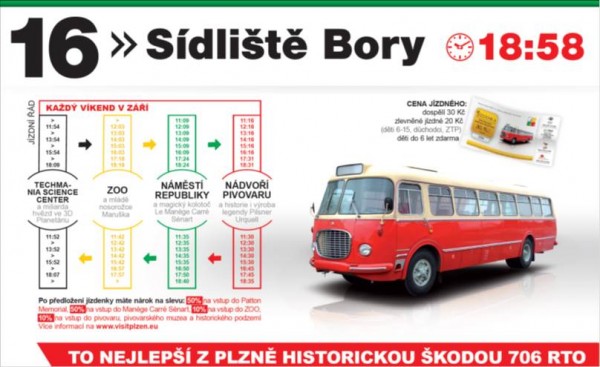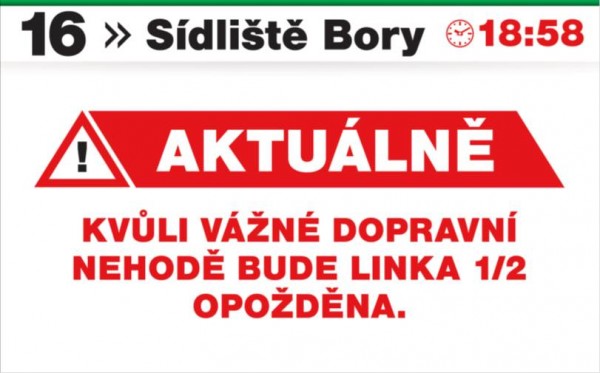Dynamic vehicle signs
New conception of vehicle LCDs and dynamic vehicle signs
Page content:
Principle of functioning of dynamic signs
How does it work? Everybody knows present information stop signs (LED or LCD) – they are meant for displaying departures from a stop or a transportation terminal and they are supplied in many versions. They receive data from a municipal public transportation or IDS dispatching and display it to passengers in the on-line mode (present departure times) or the off-line mode (departure times according to a schedule).
Our conception of dynamic vehicle signs significantly broadens this understanding. If there is on-line stop departure data at the dispatching (the dispatching system makes predictions) why shouldn’t it be displayed to the passengers in a vehicle while the vehicle is travelling to the next stop where it is possible to change to other lines.
Principle of functioning of the dynamic vehicle sign system:
- The on-board computer (in this case our EPIS 4.0x) collects position data from GPS and assesses it in relation to the schedule.
- Position information is sent via a radio network (e.g. our solution EPIS FDNET) to the dispatching in set intervals.
- Here the information is processed by the dispatching SW (e.g. our SW SPRINTER for Municipal Public transportation or integrated transportation systems) that again assesses the position in relation to the schedule and displays this information to dispatchers. Another output is also information about departures from individual stops in the scope of a system of municipal public transportation or of an integrated transportation system (hereinafter IDS) (this output does not depend on the existence of an actual stop sign).
- Information about the position a vehicle is approaching is sent back to the vehicle on-board computer. In this case, it is necessary to use a fast data network i.e. at least GPRS or better yet UMTS.
- The on-board computer processes the data and sends it to the vehicle LCD for passengers, e.g. our VCS 185 or VCS 190, etc.. In the LCD, a suitable SW application capable of processing and displaying such data has to be running.
From all this it follows that the system has to contain a number of interconnected data transfer systems – collecting vehicle position data, processing the data at the dispatching, sending the data back to the vehicle based on its position and subsequently displaying it on an LCD for passengers and if needed displaying it to the driver in the form of a notification of a connection.
System of displaying information on inner LCDs
Division into time sections
The system of displaying information on inner LCDs is based on dividing the time interval of displaying various information between individual stops into cycles similarly to inner LED panels.
The time intervals include:
- Standing of the vehicle at a stop – time T0
- Time after closing of the doors – displaying transportation information about the vehicle route – time T1
- Time for advertisements and general news – time T2
- Time for transportation information or news from the dispatching or the on-board computer – time T3
- Time for advertisements if there are any – time T4
Standing at a stop screen
The basic screen is for when the vehicle is standing at a stop. The route of the vehicle is displayed including the following stops with connections and arrival times according to the schedule, Tariff zones are also included.
The screen of a dynamic vehicle sign
The screen of a dynamic vehicle sign will make it possible to display connection data acquired form one of the dispatching of Municipal public transportation for from an IDS. This information is displayed before the vehicle gets to the stop and the passengers thus know when connections depart from the stop in question. The system can display information on-line and if there is no connection also off-line (according to the schedule saved in the EPIS 4.0x on-board computer).
Possibility of displaying current news
The system can display two types of text information:
- off-line information saved in the on-board computer, this information is created in the EPCOMP SW for data compilation for on-board computers.
- on-line information sent as a text message from the dispatching, the AGM form is the best (automatically generated messages from the dispatching).
The possibilities of displaying notes prepared offline in the on-board computer.
Displaying current transportation news sent from the dispatching – i.e. text or code messages sent from the dispatching to the vehicle.
Displaying advertisements and transportation information
Transportation information – one of display possibilities. Transportation information means information provided by a transportation company (municipal public transportation or IDS) that specifies the traffic situation (traffic closures, changes, tariffs, etc.).
Displaying advertisements in vehicles is also possible – see description „Remotely controlled information system″. The combination of advertisements (the bottom part of the screen) and information about the direction of the vehicle, the next stop, zone, time etc. (the upper part of the LCD screen) seems very advantageous for passengers. Advertisements are displayed in the form of spots determined by the inner LCD panel specs (usable formats).
Have a look at other related pages:
- Remotely controlled advertisement system - Shows how to order an advertisement system in public transportation vehicles,
- On-board computers for public transportation – EPIS 4.0x – the system can be added to all the on-board computer versions,
- On-board computers for VLD[1] – EPIS 5FCx – The system can be integrated in these computers (is being prepared),
- EPG 4.0 – GSM/GPRS/UMTS modem providing communication in the system with EPIS 4.0x
- IDS dispatching control system – provides data to LCDs in the scope of a region
- Public transportation dispatching control system – Provides data to LCDs in the scope of municipal public transportation
- Inner vehicle LCD – the target for the data to be displayed to the passengers
 Site map
Site map






